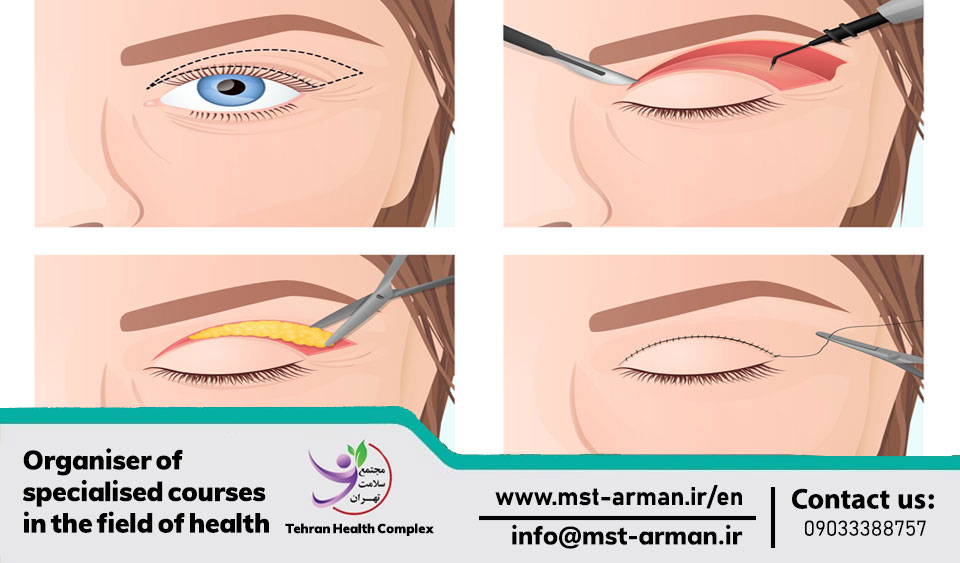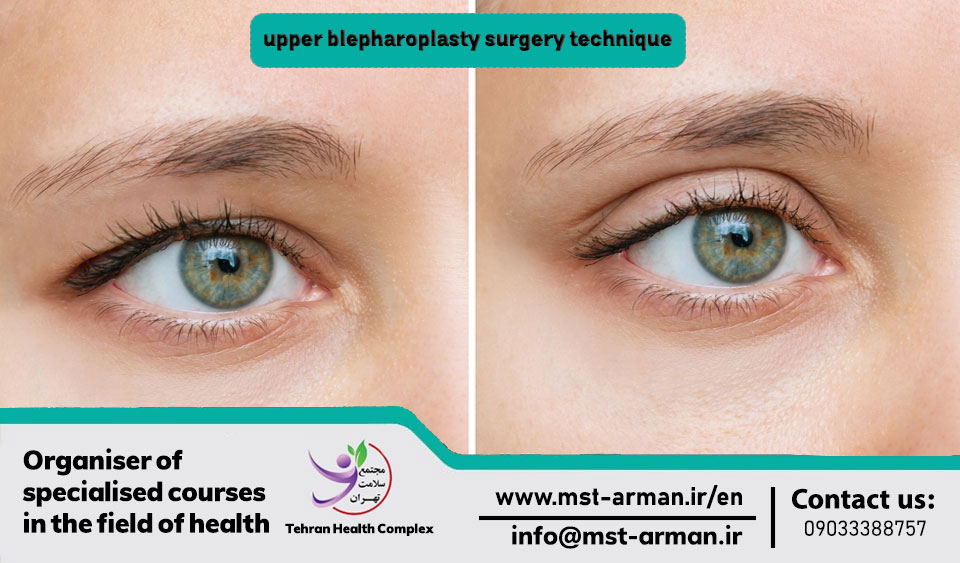Are you tired of constantly looking tired? Do you find yourself struggling with droopy eyelids? If so, then upper blepharoplasty surgery technique is the solution for you. Upper blepharoplasty, also known as eyelid lift surgery, is a technique that can effectively rejuvenate and enhance the appearance of your eyes.
This procedure involves the removal of excess skin and fat from the upper eyelids, resulting in a more youthful and refreshed look. Not only does it address functional concerns such as impaired vision and eye strain caused by heavy eyelids, but it also provides a significant cosmetic improvement by restoring the natural contour and symmetry of the upper eyelids.
Imagine waking up every morning with well-rested and vibrant eyes, ready to take on the day with confidence. The upper blepharoplasty surgery technique can help you achieve just that. Say goodbye to saggy eyelids and hello to a brighter, more youthful appearance. in addition You can register for the blepharoplasty course right now
What is the upper blepharoplasty?
Before we starting about the techniques of the upper blepharoplasty, first you should know what is the upper blepharoplasty. Upper blepharoplasty, also known as eyelid surgery, is a popular cosmetic procedure designed to rejuvenate the appearance of the upper eyelids. This technique primarily focuses on correcting saggy eyelids or removing excess skin and fat deposits that may be causing a tired or aged look.
How is upper blepharoplasty performed?
The procedure begins with the administration of local anesthesia to ensure patient comfort throughout. The surgeon then makes a discreet incision along the natural crease of the upper eyelid, allowing for minimal scarring once healed. Careful precision is employed to remove excess skin and fat, resulting in a more defined eyelid contour.
In some cases, the surgeon may also tighten the underlying muscles for optimal results. Once the desired corrections have been made, the incision is meticulously closed using fine sutures.
what are the upper blepharoplasty surgery techniques?

upper blepharoplasty surgery techniques
There are different techniques used in upper blepharoplasty surgery, including:
- Traditional or Full Incision Technique: This technique involves making an incision along the natural crease of the upper eyelid, allowing the surgeon to access the underlying tissues. Excess skin, fat, and muscle are removed, and the incision is then carefully closed with sutures.
- Transconjunctival Technique: In this technique, the incision is made on the inside of the upper eyelid. This approach is typically used when only fat removal is required, without the need for skin excision. It results in a scarless technique as the incision is hidden inside the eyelid.
- Laser-Assisted Technique: This technique involves the use of a laser to make the incision and remove excess tissue. The laser helps to minimize bleeding during the procedure and can also promote faster healing. It is often used in combination with other surgical techniques.
- Pinch Technique: The pinch technique is a minimally invasive approach that is suitable for patients with mild to moderate excess skin. It involves the removal of a small amount of skin between the thumb and forefinger, creating a natural-looking eyelid crease. This technique is less invasive and requires smaller incisions.
Advantages and disadvantages of upper blepharoplasty surgery technique
| Technique | Advantages | Disadvantages |
| Traditional or new Incision Technique |
|
|
| Transconjunctival Technique |
|
|
| Laser-Assisted Technique |
|
|
| Pinch Technique |
|
|
Who should not get upper blepharoplasty surgery?
While upper blepharoplasty is generally a safe procedure, there are certain individuals who may not be suitable candidates for the surgery. The following are some considerations:
- Unstable medical conditions: Patients with unstable or poorly controlled medical conditions, such as uncontrolled high blood pressure, uncontrolled diabetes, or heart disease, may not be good candidates for surgery. It is important to have these conditions under control before considering any elective surgery.
- Eye conditions: Individuals with certain eye conditions, such as dry eye syndrome, glaucoma, or severe eye infections, may not be suitable for upper blepharoplasty. These conditions can increase the risk of complications during or after surgery.
- Unrealistic expectations: It is important for patients to have realistic expectations about the outcomes of the surgery. Blepharoplasty can improve the appearance of the upper eyelids, but it cannot completely change one’s facial features or address other concerns such as crow’s feet or wrinkles around the eyes.
- Insufficient eyelid tissue: In some cases, individuals may not have enough excess skin or fat in the upper eyelids to warrant surgery. A thorough evaluation by a qualified plastic surgeon is necessary to determine if the patient has enough tissue for the procedure.
- Pregnancy or breastfeeding: It is generally recommended to postpone elective cosmetic surgeries, including blepharoplasty, until after pregnancy and breastfeeding. Hormonal changes and potential complications associated with these phases may affect the results and healing process.
- Psychological conditions: Patients with certain psychological conditions or unrealistic body image expectations may not be suitable candidates for surgery. It is essential for individuals to have a clear understanding of their motivations and have realistic expectations about the outcomes.
It is important to consult with a qualified and experienced plastic surgeon who can evaluate your individual circumstances and medical history to determine if you are a suitable candidate for upper blepharoplasty or if alternative treatments may be more appropriate for your specific needs.
Last word
As you know we talked about upper blepharoplasty surgery technique and you have noticed that the upper techniques of blepharoplasty have some advantages and disadvantages. From this point of view, in Tehran Health Complex, all blepharoplasty techniques are taught with comprehensive and complete topics.
Frequently asked questions about upper blepharoplasty surgery technique
- What is the best age for eyelid surgery?
the best age for upper blepharoplasty surgery is between 25 to 50. - What are the upper blepharoplasty surgery techniques?
the techniques are Traditional or Full Incision Technique, Transconjunctival Technique, Laser-Assisted Technique and Pinch Technique. - Is upper blepharoplasty surgery painful?
Upper blepharoplasty is typically performed under local anesthesia, so you will be awake but won’t feel any pain during the procedure. Some patients may experience mild discomfort or tightness afterward, but this can be managed with pain medication prescribed by your surgeon. - How long does upper blepharoplasty surgery take?
The duration of the surgery depends on various factors, including the specific technique used and the extent of the procedure. On average, upper blepharoplasty surgery typically takes about 1 to 2 hours. - Will upper blepharoplasty surgery leave visible scars?
The extent of scarring depends on the technique used. With the traditional incision technique, there will be a scar along the natural crease of the eyelid, but it generally fades and becomes less noticeable over time. The transconjunctival technique leaves no visible external scar as the incision is made on the inside of the eyelid. - What is the recovery period like after upper blepharoplasty surgery?
Recovery time can vary from person to person, but most patients can expect to resume normal activities within 7 to 10 days. You may experience swelling, bruising, and some discomfort during the initial days after surgery, but these symptoms gradually subside. - Will upper blepharoplasty surgery affect my vision?
Upper blepharoplasty surgery is primarily performed to improve the appearance of the eyelids. However, in cases where excessive eyelid skin is impairing your vision, the surgery can help improve your visual field.


